In this post I will show you how to analyse Power BI Desktop diagnostic trace files in a more visual way than notepad ![]()
First you need to collect some diagnostics by enabling tracing on Power BI Desktop, go to: File –> Options –> Diagnostics –> Enable Tracing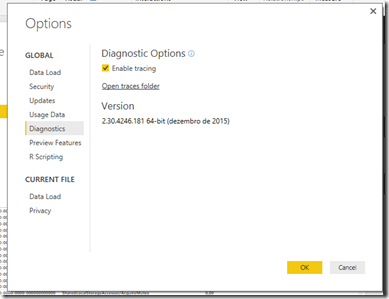
If you click on “Open Traces folder”:
It will open the trace folder with all the trace logs:
PS – Trace log are only generated after you test your power bi report, do some refresh and interactions first to create the trace logs
Now to analyse these logs you could off course open them in notepad:
But is not very easy to read, so what better way to process and visualize this huge amount of text data??? Power BI off course!!!
So I created a Power BI Desktop to process and visualize the trace logs, that will allow you to quickly visualize things like:
- Errors
- Duration of queries
- Performance issues
- etc
Instructions of usage:
- Download and open the Power BI Desktop file
- “Edit Queries” and change the variable “VAR_LogFolder” to point to the trace logs folder:
- Refresh the Report
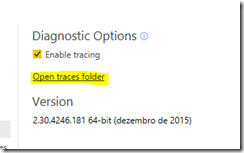
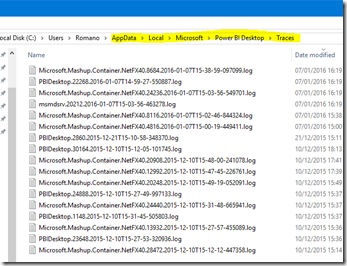
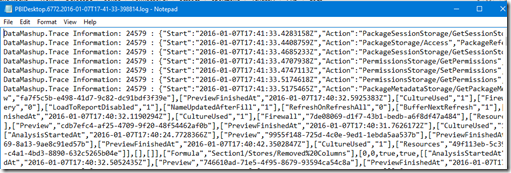
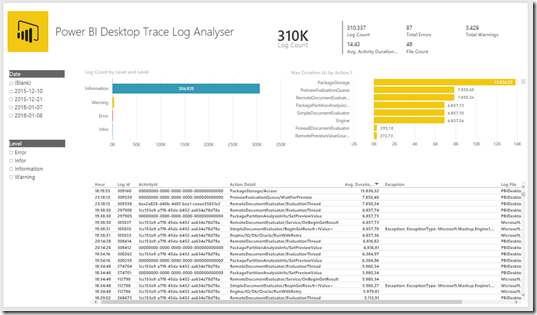
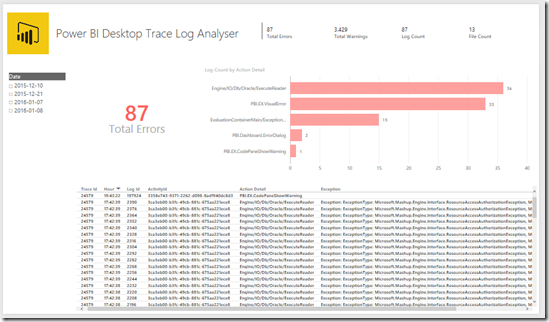



Perfect! Nice one! 🙂 Kudos
This is fantastic Rui. My trace is dominated by PackageStorage: any idea what that is (I can guess…)? And how it might be optimised (i.e. reduced)? I’m working with a complex Query that used to run fast but now gets bogged down and takes 30mins or so to complete (running across 20GB of data of course…)
It is really nice! I will give 100 kudos 🙂
Are there any documents online for what the Action Details are actually doing? I’m trying to dig into why some of my Power BI solutions are slower than others.
Hi,
I am unable to change the datsource in Var_LogFolder variable and also in DataSource Settings.
Please help!
Im not able to change the datasource in Var_LogFolder variable to my local trace path.Please help!!!
What error you are getting? it quite simple as explained above. Edit query and change the value of var_logfolder. i’m interested to know how he is actually parsing the log file. I wanted to parse different log file. Even when i tried to read the Power Bi trace file i couldn’t do it. the file is not a comma separated.. I think he is using DAX skill to parse this file can you help us explain this party i got this code and i think you are using this to parse file isn’t ?
let
Source = Folder.Files(VAR_LogFolder),
#”Filtered Rows” = Table.SelectRows(Source, each ([Extension] = “.log”)),
#”Removed ColumnsA” = Table.RemoveColumns(#”Filtered Rows”,{“Extension”, “Date accessed”, “Date created”, “Attributes”, “Folder Path”}),
#”Renamed ColumnsP” = Table.RenameColumns(#”Removed ColumnsA”,{{“Name”, “Log File”}, {“Date modified”, “Log File Date”}}),
#”Added Custom” = Table.AddColumn(#”Renamed ColumnsP”, “LogText”, each Lines.FromBinary([Content])),
#”Removed ColumnsX” = Table.RemoveColumns(#”Added Custom”,{“Content”}),
#”Expanded LogText” = Table.ExpandListColumn(#”Removed ColumnsX”, “LogText”),
#”Split Column by Delimiter” = Table.SplitColumn(#”Expanded LogText”,”LogText”,Splitter.SplitTextByEachDelimiter({” : “}, QuoteStyle.None, false),{“Column1.1”, “Column1.2″}),
#”Split Column by Delimiter1″ = Table.SplitColumn(#”Split Column by Delimiter”,”Column1.1″,Splitter.SplitTextByEachDelimiter({“:”}, QuoteStyle.Csv, false),{“Column1.1.1”, “Column1.1.2″}),
#”Split Column by Delimiter2″ = Table.SplitColumn(#”Split Column by Delimiter1″,”Column1.1.1”,Splitter.SplitTextByEachDelimiter({“.”}, QuoteStyle.Csv, false),{“Column1.1.1.1”, “Column1.1.1.2″}),
#”Changed Type” = Table.TransformColumnTypes(#”Split Column by Delimiter2″,{{“Column1.1.1.1”, type text}, {“Column1.1.1.2”, type text}, {“Column1.1.2”, Int64.Type}, {“Column1.2″, type text}}),
#”Removed Columns” = Table.RemoveColumns(#”Changed Type”,{“Column1.1.1.1″}),
#”Split Column by Delimiter3″ = Table.SplitColumn(#”Removed Columns”,”Column1.1.1.2″,Splitter.SplitTextByEachDelimiter({” “}, QuoteStyle.Csv, false),{“Column1.1.1.2.1”, “Column1.1.1.2.2″}),
#”Changed Type1″ = Table.TransformColumnTypes(#”Split Column by Delimiter3”,{{“Column1.1.1.2.1”, type text}, {“Column1.1.1.2.2″, type text}}),
#”Removed Columns1″ = Table.RemoveColumns(#”Changed Type1”,{“Column1.1.1.2.1″}),
#”Renamed Columns” = Table.RenameColumns(#”Removed Columns1″,{{“Column1.1.1.2.2”, “Level”}, {“Column1.1.2”, “Trace Id”}}),
#”Parsed JSON” = Table.TransformColumns(#”Renamed Columns”,{{“Column1.2″, Json.Document}}),
#”Expanded Column1.2″ = Table.ExpandRecordColumn(#”Parsed JSON”, “Column1.2”, {“Start”, “Action”, “ProductVersion”, “ActivityId”, “Process”, “Pid”, “Tid”, “Duration”, “DbProviderName”, “Exception”, “CommandText”, “ResponseFieldCount”, “evaluationID”}, {“Start”, “Action”, “ProductVersion”, “ActivityId”, “Process”, “Pid”, “Tid”, “Duration”, “DbProviderName”, “Exception”, “CommandText”, “ResponseFieldCount”, “evaluationID”}),
#”Changed Type2″ = Table.TransformColumnTypes(#”Expanded Column1.2″,{{“Start”, type datetime}, {“Duration”, type duration}}),
#”Calculated Total Seconds” = Table.TransformColumns(#”Changed Type2″,{{“Duration”, Duration.TotalSeconds}}),
#”Changed Type3″ = Table.TransformColumnTypes(#”Calculated Total Seconds”,{{“evaluationID”, Int64.Type}, {“ResponseFieldCount”, Int64.Type}, {“Tid”, Int64.Type}, {“Pid”, Int64.Type}}),
#”Added Index” = Table.AddIndexColumn(#”Changed Type3″, “Index”, 1, 1),
#”Renamed Columns1″ = Table.RenameColumns(#”Added Index”,{{“Index”, “Log Id”}, {“evaluationID”, “EvaluationId”}}),
#”Duplicated Column” = Table.DuplicateColumn(#”Renamed Columns1″, “Action”, “Action – Copy”),
#”Renamed Columns2″ = Table.RenameColumns(#”Duplicated Column”,{{“Action – Copy”, “Action Detail”}}),
#”Reordered Columns” = Table.ReorderColumns(#”Renamed Columns2″,{“Log File”, “Log File Date”, “Level”, “Trace Id”, “Start”, “Action”, “Action Detail”, “ProductVersion”, “ActivityId”, “Process”, “Pid”, “Tid”, “Duration”, “DbProviderName”, “Exception”, “CommandText”, “ResponseFieldCount”, “EvaluationId”, “Log Id”}),
#”Split Column by Delimiter4″ = Table.SplitColumn(#”Reordered Columns”,”Action”,Splitter.SplitTextByDelimiter(“/”, QuoteStyle.Csv),{“Action.1”, “Action.2”, “Action.3”, “Action.4”, “Action.5”, “Action.6″}),
#”Changed Type4″ = Table.TransformColumnTypes(#”Split Column by Delimiter4”,{{“Action.1”, type text}, {“Action.2”, type text}, {“Action.3”, type text}, {“Action.4”, type text}, {“Action.5”, type text}, {“Action.6″, type text}}),
#”Duplicated Column1″ = Table.DuplicateColumn(#”Changed Type4”, “Start”, “Start – Copy”),
#”Changed Type5″ = Table.TransformColumnTypes(#”Duplicated Column1″,{{“Start – Copy”, type time}}),
#”Renamed Columns3″ = Table.RenameColumns(#”Changed Type5″,{{“Start – Copy”, “Hour”}, {“Start”, “Date”}}),
#”Changed Type6″ = Table.TransformColumnTypes(#”Renamed Columns3″,{{“Date”, type date}}),
#”Filtered Rows1″ = Table.SelectRows(#”Changed Type6″, each ([Level] null and [Level] “”))
in
#”Filtered Rows1″
Skype has opened up its online-structured consumer beta to
the entire world, soon after starting it largely within the U.S.
and U.K. previously this four weeks. Skype for Web also now can handle Chromebook and Linux for immediate text messaging conversation (no voice and
video however, those need a connect-in set up).
The expansion in the beta brings support for an extended listing of
spoken languages to assist reinforce that
international user friendliness
Unable to download file.
Hi Dave, just tested the url and it’s ok… Could it be a proxy validation?
If you still have issues go directly to the github repository: https://github.com/DevScope/powerbi-trace-analyser
Amazing! Thank you!
Hi,
It seems log files format changed.
Any idea of what to modify in the pbix to make it work ?
Thx for any help.
Jeff
Hi Jeff, you should only change the Power Query (Edit Query Window). I’ll try to take a look into it this week and update a new pbix.
Regards
Hi Rui, thanks a lot !
Hi there,
I’m getting the following error after changing the var_logfolder variable: “Expression.Error: Couldn’t convert a value of type List in type Text.”
The path the logs are being saved by Power BI is C:\Users\eleonora\Microsoft\Power BI Desktop Store App\Traces.
Any idea of how to fix it?
Thanks,
Eleonora.
Hello. Did you resolve this problem?
Is this only error logs or do they contain data regarding usage and the user as well?
Thanks
Erik Liffner
Wow, very good, thanks a lot for doint it.
Reblogged this on ideiasdefenestradas and commented:
Esse cara teve a manha: fez um dashboard com PowerBI para mostrar o log do próprio PowerBI (desktop).
Hi, I’m getting following error while doing refresh (after setting my trace path)
“We cannot convert a value of type List to type Text.”
I’ll have to bookmark that for now.
Have looked in both Windows explorer\file and Outlook 365\file. There is no diagnostics link that I can find. Any other ideas?
This was very helpful, thank you!
MAN I LOVE YOU THANK YOU VERY MUCH!!!!!!!!!!!!!!!!!!!!!!!!!!!!!!!!!!!!!!!!!!!!!!!!!!!
Wonderful ideia! Thanks a lot!